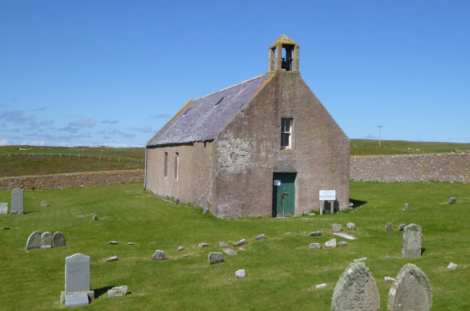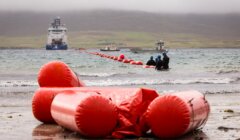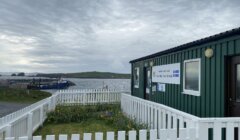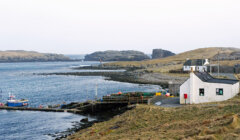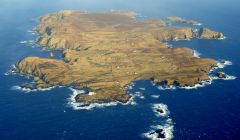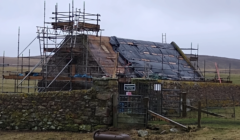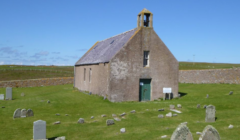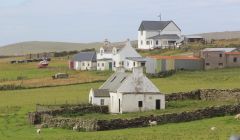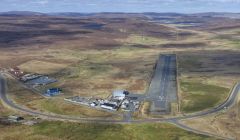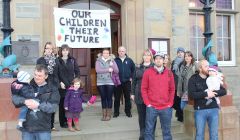Council / Councillors overturn planning refusal for solar panels on historic island church
COUNCILLORS have reversed a decision by planning officers to refuse consent for solar panels on a historic church on the outlying Shetland island of Papa Stour.
Elected members made the decision regarding the Papa Stour kirk on Wednesday when the original refusal came up for review.
Installing 12 black solar panels on the B-listed building is hoped to reduce energy bills and make the building, which is undergoing major refurbishment, more sustainable.
Shetland Islands Council (SIC) planning officers refused Papa Stour History and Community Group’s initial application earlier this year, saying it would “adversely impact the special architectural and historic interest of the building”.
However, members of the SIC’s planning committee sided with the applicants – with plenty of praise for their work in renovating the kirk.
The appeal had the support of Shetland MSP Beatrice Wishart as well as the local community council.
The kirk is more than 200 years old and is owned by the local history and community group.
The project to renovate the property and turn it into a community hub – and a place for visitors to drop by – has attracted hundreds of thousands of pounds of funding.
Papa Stour, which takes around 40 minutes to reach by ferry, has the smallest population of Shetland’s inhabited islands – with less than ten reported to be living there.
It also has no specific community building, such as a public hall.
The community group argued that the panels would be hidden from view by people accessing the building.
They also questioned why the application had been turned down given the B-listed St Andrew Episcopal Church in Fife was previously given the green light to install 22 photovoltaic panels.
Writing in support of the appeal, MSP Wishart said “solar panels appear an elegant solution to environmental and cost concerns for a project seeking to create a community space on one of Shetland’s smallest inhabited islands”.
Become a member of Shetland News
Whilst saying in a letter she did not have all the relevant information, Wishart added that she was “slightly surprised” by the decision.
The Sandness and Walls Community Council said it felt that “every measure possible” should be taken to encourage green energy initiatives, and added that the church continuing to use electricity could bring the whole kirk project into question.
At the meeting planning officer Marianna Porter said while there is an understanding of the benefits of renewable energy, solar panels would be an “unsympathetic addition” to the historic kirk.
She said renewables for buildings should be “carefully and discreetly” located.
The meeting heard from the community group that other alternative methods of renewable power would not be considered viable.
Porter added that planning advice states that every case should be judged on its own merits, and cases elsewhere do not set a precedent.
The application also includes reharling the exterior with a white finish, but the meeting heard that work on this had already been carried out by an expert contractor in a colour close to the kirk’s original appearance.
Jane Puckey, who represents Papa Stour on the Sandness and Walls Community Council, said the kirk has been a “beacon of hope” for the island for more than two centuries, and the hope was to preserve it for future generations.
She said the panels would be most visible from across the water in Sandness – and even then folk would need binoculars to see them.
Peter Bardell from the Papa Stour group also said the kirk would likely have been left to ruin without the renovation, with it suffering from a leaking roof, damaged electrics water ingress and some rotten floors prior to work starting.
“Eventually the roof would have come off the building, and the building would have been lost,” he said, adding that it is now wind and watertight.
During debate North Isles councillor Robert Thomson noted that the community group took advice from a “very highly qualified conservation architect”.
He felt that the panels would have a “very limited visual impact” and the idea of solar panels was “entirely reasonable”.
Shetland Central member Catherine Hughson said the community group has done a “huge amount of work” on the church and said the panels would “not be unsightly”.
Meanwhile Shetland West councillor Mark Robinson, whose ward includes Papa Stour, said: “This is a community led scheme by a very small community…what they’re achieving here is, in my mind, absolutely amazing.”
Supporting the application, he said the kirk needs to be sustainable if the renovation project is to be a success.
Lerwick councillor Arwed Wenger also supported the applicants, while fellow town member Cecil Smith sought to remind colleagues that planning officers are only working to the regulations in front of them.
Planning committee vice-chair Davie Sandison said there was a balance to be struck when interpreting planning policy.
But he felt convinced that there was enough evidence to show the impact would not be severe.
Meanwhile committee chair Robbie McGregor, who represents Shetland South, said he was “jealous” of the work done in Papa Stour given that he can see the derelict Quarff church out of his window.
“I’m just so pleased to hear what conservation has been achieved by the community, which is very small indeed,” he said.
Become a member of Shetland News
Shetland News is asking its many readers to consider paying for membership to get additional features and services: -
- Remove non-local ads;
- Bookmark posts to read later;
- Exclusive curated weekly newsletter;
- Hide membership messages;
- Comments open for discussion.
If you appreciate what we do and feel strongly about impartial local journalism, then please become a member of Shetland News by either making a single payment, or setting up a monthly, quarterly or yearly subscription.
















